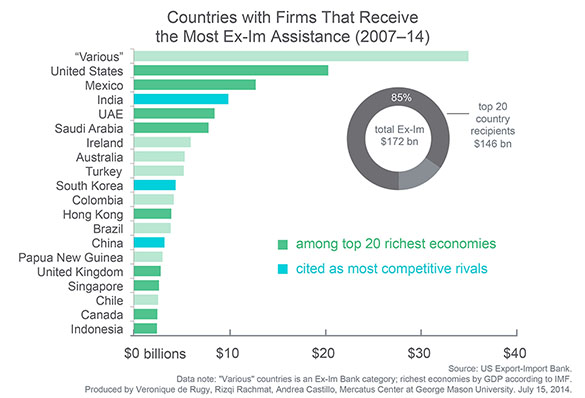- | Government Spending Government Spending
- | Data Visualizations Data Visualizations
- |
Export-Import Bank Assistance to Foreign Firms by Country
The Export-Import Bank of the United States claims to boost US exports by providing artificially cheap financing to overseas buyers of certain US products. The Ex-Im Bank and its supporters rarely discuss which countries’ firms actually receive US export credit subsidies.
The Export-Import Bank of the United States claims to boost US exports by providing artificially cheap financing to overseas buyers of certain US products. The Ex-Im Bank and its supporters rarely discuss which countries’ firms actually receive US export credit subsidies.
This week’s chart uses the Ex-Im Bank’s own data to determine the recipients of the bulk of Ex-Im Bank financing by nation. We pulled all Ex-Im Bank data available for transactions from FY 2007 to FY 2014 and combined the total authorization amounts approved for each country value that the Bank provided. We then ranked each country value from largest to smallest to determine which countries’ businesses received the bulk of Ex-Im assistance.
As is typical with the Export-Import Bank datasets, some of their data labeling is unclear or simply not provided. Almost $35 billion in Ex-Im Bank assistance over the past seven fiscal years, the largest amount, was labeled “Various Countries.” These transactions were overwhelmingly part of the Bank’s insurance portfolio. Unfortunately, these transactions’ details did not provide many clues that might point to the country of origin. The data for the Primary Suppliers, Primary Buyers, and Primary Source of Repayment are simply labeled “Unknown” or “Various – Insurance.” Such unclear labeling does not help curious Americans to determine exactly which projects their tax dollars are backing.
The next largest recipient is, unexpectedly, the United States itself, receiving a little over $20 billion in financing since FY 2007. These transactions overwhelmingly belong to Ex-Im Bank’s Working Capital Guarantee Program, which provides commercial lenders to US exporters with a 90 percent loan-backing guarantee. Observers of the Ex-Im Bank debate may be surprised to see the Bank reporting that such a substantial portion of its portfolio goes so directly to US businesses, many of which compete against unsubsidized US businesses, rather than supporting foreign buyers of US goods, as is the stated goal of the assistance program.
The remainder of the chart displays data on the remaining top 18 foreign nations with firms that receive Ex-Im Bank financing, along with the top twenty nation’s portion of the Bank’s whole portfolio. Businesses in the top twenty nations pulled in roughly $146 billion, or 85 percent, of the Bank’s $176 billion in assistance from FY 2007 to FY 2014.
Many of the firms that received the most assistance are located in wealthy countries—like Australia, Singapore, Hong Kong, and the United Kingdom—that are unlikely to present the kind of political or external financing risks that Ex-Im is purported to be necessary to counteract.
Oil-rich nations, like Saudi Arabia and the United Arab Emirates, are also high on the list.
A few of the top countries—like India, South Korea, and China—are often pointed to as examples of foreign nations that engage in protectionism that the Export-Import Bank must counteract.
Of course, we are unable to determine which businesses in which countries received aid under the largest “Various Countries” category, so the true amounts may change the ranking. Nonetheless, the Ex-Im Bank’s data offer little support for the claim that its efforts are largely targeted at offsetting foreign export subsidies.


